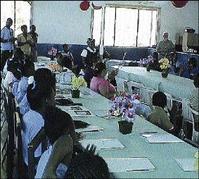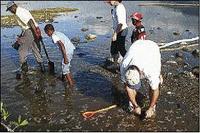Agostinho Pinnock, Contributor

Children doing a wetland quiz and receiving prizes.
February 2 to 3 marked the culmination of activities in celebration of World Wetlands Day, an annual international environmental festival observed on February 2, the anniversary of the signing of the Treaty on Wetlands in the Iranian city of Ramsar in 1971. At the end of the weekend, the National Ramsar Committee (NRC) was satisfied that there was an increased demand for information on wetlands by students and teachers, its primary demographic, who were able to identify the importance of these resources to Jamaica.
Black River, the site of Jamaica's first designated Wetland of International Importance, which also celebrated its 10th anniversary this year, was the focus of national activities. Students and teachers from the area received hands-on exposure, courtesy of a study tour of the Black River Lower Morass, which was complemented by lecture presentations by the National Environment and Planning Agency (NEPA). John Fletcher of Bird Life Jamaica augmented these efforts. He said that wetlands were homes to many rare and endemic birds. Broadcaster Dervan Malcolm was also on site to assist the NRC's public education efforts. He foregrounded the importance of Jamaica's biological diversity and the need for protected areas in his report, courtesy of an outside broadcast on POWER 106 FM from the Bridge House Inn.
Economic and pharmaceutical benefits
Chairman of the NRC, Dr Dale Webber, doubled as 'tour guide', guiding the excited students through the morass. He said that the morass' flora and fauna had numerous environmental, economic and pharmaceutical benefits. Among them, Dr Webber said the Red Mangrove, a species native to Jamaica, provides important habitat for some organisms (Ascidians) used in the manufacturing of the drug Ectinacidin , which has been proven to slow the growth of cancerous cells and is being marketed by a Spanish pharmaceutical company.
The students and teachers, who hailed from the Hampton School, Lacovia Primary and the Black River Primary and Infant School, openly, raved about the information they received and chattered out loud when crocodiles and other aspects of the area's rich biodiversity were spotted.
In Kingston, volunteers from The Queen's and Port Royal all-age schools, along with members of The University of the West Indies, Mona campus, the Forestry Department and other volunteers, planted about 700 seedlings of coastal plants along the Palisadoes. These included the Black and Red Mangrove and the Seaside Mahoe. Camilo Trench, science officer for the Port Royal Marine Laboratory's Port Royal-Palisadoes Mangrove Replanting Project, informed media personnel, some of whom had assembled on site, about the many benefits mangroves provided.
A similar tone was in effect at Mason River and the Montego Marine Park. The Institute of Jamaica's Natural History Division and the Montego Bay Marine Trust and the Urban Development Corporation (UDC), respectively, conducted study tours of these wetlands for students from these areas. NEPA and the Negril Environmental Protection Trust (NEPT) conducted a similar tour of the Royal Palm Reserve in Negril.
The Caribbean-Coastal Area Management (CCAM) staged a World Wetlands Day exhibition at its offices in Lionel Town, Clarendon and a post-Hurricane Dean Netball rally at the Bustamante High School, also in the parish, on Sunday, February 3.
The MIAS is a non-profit organisation of the University of the West Indies, Pure and Applied Sciences Department, offering analytical, technical and web services and specialised science projects. If you have any question or comments about these articles please email: mias@uwimona.edu.jm or contact the MIAS Analytical Services Division at 970-2042 or 512-3067 for enquires on services offered.

Some volunteers at work planting seedlings along the Palisadoes.

